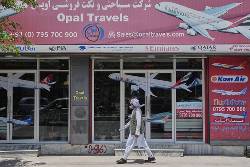DAKAR, Senegal (AP) — President Donald Trump has banned citizens of 12 countries from entering the United States and restricted access for those from seven others, citing national security concerns in resurrecting and expanding a hallmark policy of his first term that will mostly affect people from Africa and the Middle East.
The ban announced Wednesday applies to citizens of Afghanistan, Myanmar, Chad, the Republic of Congo, Equatorial Guinea, Eritrea, Haiti, Iran, Libya, Somalia, Sudan and Yemen. The heightened restrictions apply to people from Burundi, Cuba, Laos, Sierra Leone, Togo, Turkmenistan and Venezuela who are outside the U.S. and don't hold a valid visa.
The policy takes effect Monday at 12:01 a.m. and does not have an end date.
Here's what to know about the new rules:
How Trump justified the ban
Since returning to the White House, Trump has launched an unprecedented campaign of immigration enforcement that has pushed the limits of executive power and clashed with federal judges trying to restrain him.
The travel ban stems from a Jan. 20 executive order Trump issued requiring the Department of State, Department of Homeland Security and the Director of National Intelligence to compile a report on “hostile attitudes” toward the U.S.
The aim is to “protect its citizens from aliens who intend to commit terrorist attacks, threaten our national security, espouse hateful ideology, or otherwise exploit the immigration laws for malevolent purposes,” the administration said.
In a video posted on social media, Trump tied the new ban to a terrorist attack Sunday in Boulder, Colorado, saying it underscored the dangers posed by some visitors who overstay visas. The man charged in the attack is from Egypt, a country that is not on Trump’s restricted list. U.S. officials say he overstayed a tourist visa.
Who is exempt from the ban
Which countries are affected
Trump said nationals of countries included in the ban pose “terrorism-related” and “public-safety” risks, as well as risks of overstaying their visas. He also said some of these countries had “deficient” screening and vetting or have historically refused to take back their citizens.
His findings rely extensively on an annual Homeland Security report about tourists, businesspeople and students who overstay U.S. visas and arrive by air or sea, singling out countries with high percentages of nationals who remain after their visas expired.
“We don’t want them,” Trump said.
The inclusion of Afghanistan angered some supporters who have worked to resettle its people. The ban makes exceptions for Afghans on special immigrant visas, who were generally the people who worked most closely with the U.S. government during the two-decade war there.
The list can be changed, the administration said in a document, if authorities in the designated countries make “material improvements” to their own rules and procedures. New countries can be added "as threats emerge around the world.”
Reactions to Trump's order
International aid groups and refugee resettlement organizations roundly condemned the ban.
“This policy is not about national security — it is about sowing division and vilifying communities that are seeking safety and opportunity in the United States,” said Abby Maxman, president of Oxfam America.
The African Union Commission expressed concern about the “the potential negative impact” of the ban on educational exchanges, business ties and broader diplomatic relations. It urged the Trump administration to adopt “a more consultative approach” with the affected countries.
The Council on American-Islamic Relations, the nation’s largest Muslim civil rights and advocacy organization, called the order “unnecessary, overbroad and ideologically motivated.”
The National Immigration Law Center said it was “outraged,” saying the ban is “ laced with unsubstantiated legal justifications.”
”The impact of this new ban will be deeply racialized, as it will effectively bar hundreds of millions of Black and Brown people from entering the United States,” the group said in a statement.
In Haiti, radio stations received a flurry of calls Thursday from angry listeners, including many who said they were Haitians living in the U.S. and who accused Trump of being racist.
“Most of the countries he attacked are countries that have a lot of Black people," one caller said.
How the ban is different from 2017
Early in Trump's first term, he issued an executive order banning travel to the U.S. by citizens of seven predominantly Muslim countries, including Iraq, Syria, Iran, Sudan, Libya, Somalia and Yemen.
It was one of the most chaotic and confusing moments of his young presidency. Travelers from those nations were either barred from getting on flights to the U.S. or detained at U.S. airports after they landed. They included students and faculty, as well as businesspeople, tourists and people visiting friends and family.
The order, often referred to as the “Muslim ban” or the “travel ban,” was retooled amid legal challenges until a version was upheld by the Supreme Court in 2018.
The ban affected various categories of travelers and immigrants from Iran, Somalia, Yemen, Syria and Libya, plus North Koreans and some Venezuelan government officials and their families.
___
Associated Press reporters Evens Sanon in Port-au-Prince, Haiti, and Dánica Coto in San Juan, Puerto Rico, contributed.
...


 Copyright © 1996 - 2025 CoreComm Internet Services, Inc. All Rights Reserved. | View our
Copyright © 1996 - 2025 CoreComm Internet Services, Inc. All Rights Reserved. | View our